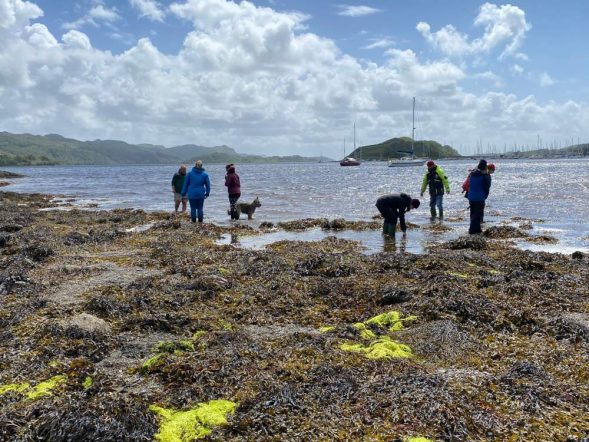
by Kerri Whiteside, Community Support Specialist at Fauna & Flora International (FFI)
Last weekend I visited the beautiful Craignish peninsula in Argyll to join Seawilding’s first ever ‘restoration training weekend’, delivered to organisations across the UK implementing restoration projects in their own waters.
Seawilding introduced the UK’s first community-led native oyster and seagrass restoration project here in 2020, and it is now committed to achieving low-cost, community-driven, restoration methods, at scale.
Those attending the weekend were each at different stages in their journey and included the Solway Firth Partnership, Restoration Forth, Ulster Wildlife, the Tees River Trust, Knoydart Climate Action Group, and Sea Kintyre.
Fauna & Flora International (FFI) is a keen supporter of Seawilding and I was lucky enough to join the weekend with both my FFI and my Seawilding Trustee hats on!
Day one – native oyster restoration
On Saturday we spent the morning in the Craignish Village Hall, kicking off with a detailed overview from Seawilding’s CEO, Danny Renton, on the background and aims of Seawilding.
Danny talked through important steps to consider when starting your own restoration initiative – from site selection to securing community involvement. Then moved to what happens after you have identified your site – such as licensing, developing your biosecurity plan, and conducting your baseline surveys.
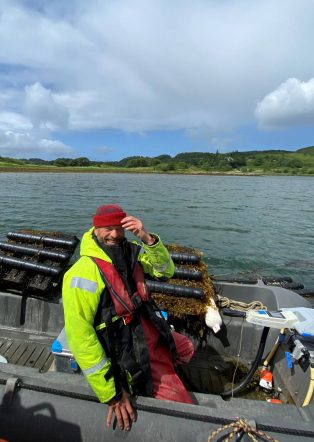
Seawilding’s in-house monitoring experts, Katherine Knight and Eric Holden, then dug into the detail of monitoring for native oysters and wider biodiversity. Next up we visited the ‘oyster hoisters’ in the Ardfern pontoons and took a boat trip to visit the native oyster nursery site.
It’s a fairly simple system – tiny juvenile native oysters (‘spat’) are sourced from a hatchery and then grown in a nursery (a series of floating cages) in the loch. When the begin their journey in the loch’s nursery, they are 6 months old and weigh approx. 1 gram (a 5p coin), they grow in the nursery over the summer months until they’re about 10 times the size (to that of a digestive biscuit), and then are released by local volunteers into shallow water.
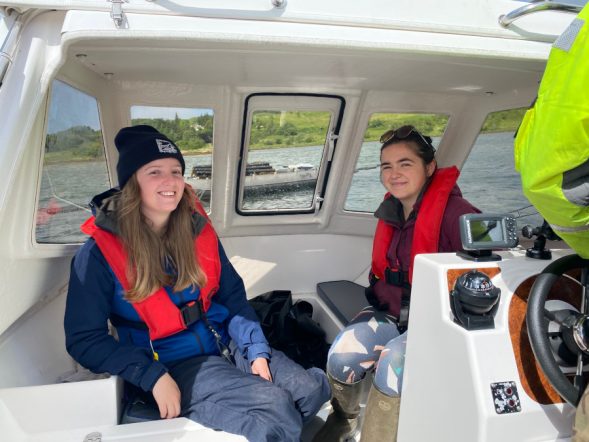
Loch Craignish is, thus far, proving to be the optimum environment for native oyster reintroduction – relic shells first alerted Seawilding to its suitability; the loch’s shallow, sheltered, (relatively) warm water provided the perfect site for an oyster nursery, with a good tidal flow with lots of larvae to feed on.
This has meant there has been no mortality in the nursery, and has produced a 40% survival rate so far, once realised onto the seabed. Impressive stats! This success has led to Seawilding already releasing a huge 220,000 native oysters onto seabed so far, with another 200,000 currently in their nursery.
After some packed lunch, we flexed our practical survey skills and put into practice what Katherine and Eric taught us.
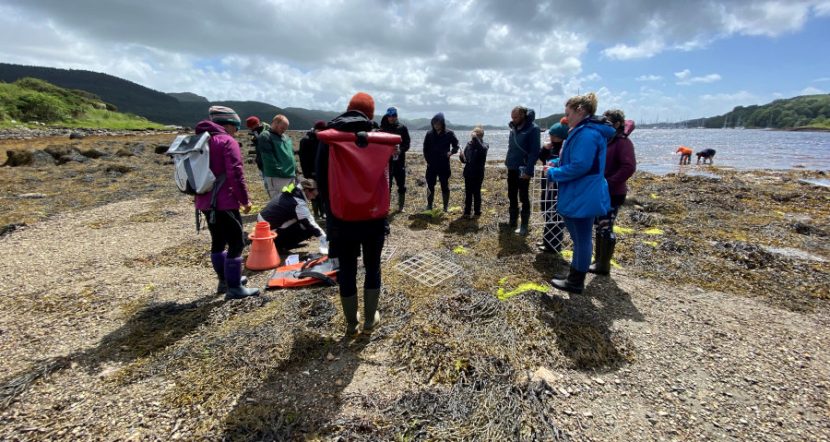

Then it was back to the village hall where Seawilding’s Phillip Price – who also runs his own local wildlife photography business Loch Visions – shared top-tips on how restoration projects can utilise social media. Seawilding take a ‘diary approach’ to social media – closely documenting what they do so that everyone (local residents, members, volunteers, funders, peers) get regular updates from the ground.
Phillip also imparted his technical knowledge on camera equipment, which we were able to put into practice on Sunday. My favourite piece of advice on this was to ask yourself before you take a photo “why am I taking this photo?” – this can really help you with your composition and allow you to take the best photo (and, if you’re anything like me, might also help reduce your phone’s ridiculous photo ream!).
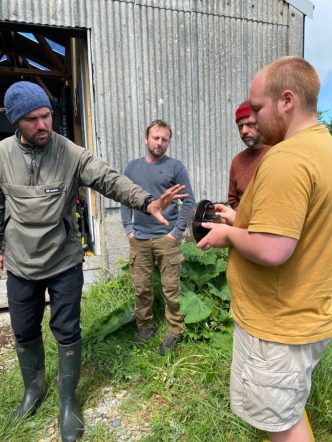
Day two – seagrass restoration
Sunday was all about seagrass restoration techniques, and this time we were located at Seawilding’s impressively kitted-out boatshed, which now houses lots of the team’s necessary equipment.
Seagrasses are the only flowering plant able to live in the ocean. Loch Craignish is home to two of the UK’s four species – common eelgrass (Zostera marina) and dwarf eelgrass (Zostera noltei), however these sites are currently small and fragmented in the loch. With the multitude of biodiversity and carbon storage benefits healthy seagrass meadows provide, restoring and better connecting them is a no-brainer.
To achieve this, Seawilding has been working closely with Project Seagrass and the Scottish Association of Marine Science (SAMS) to deploy a ‘sack and seed’ methodology, via NatureScot funding. This involves seagrass being gathered by hand, the seed then being extracted and placed in small hessian bags, and the hessian bags finally being tethered to the seabed to germinate.
After another session from Danny on Sunday morning to set the scene, Will Goudy, who leads on Seawilding’s seagrass work, talked us through the seagrass processing systems in the boatshed. You can check out Seawilding’s ‘how to’ videos directly, for an excellent insight into the technical knowledge Will shared with us – How-to Instructional Videos | Seawilding.
This was followed by more specific seagrass monitoring techniques from Katherine and Eric. The surveying components of Seawilding’s work really shouldn’t be underestimated – not only is Seawilding regularly assessing the loch’s habitat to determine if there is a restoration opportunity (measuring physical conditions like temperature and light), once restoration has begun, they then monitor the restoration area itself, the sediment adjacent to it, the ‘donor bed’ area (to ensure it is not being negatively impacted), and a control site.
FFI has directly invested in Seawilding monitoring capabilities through our Community Support Fund, and we know the interest from community-based organisations across Scotland in developing these skills is only increasing.
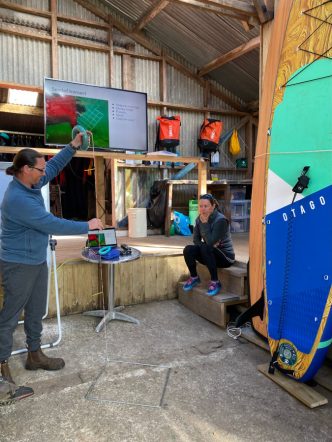
What am I taking away from the weekend?
(Other than my photo skills needing a fair bit more work!)
Reflecting on the weekend from FFI’s perspective of supporting community-led conservation in Scotland, the weekend really hammered home to me how you simply can’t replace the value of community organisations directly sharing their skills and experiences with one another. Although those who joined will return to their own local setting, and will no doubt adapt their newly-taught skills as necessary, you just can’t beat learning in situ, and being able to draw from others’ hands-on experiences.
It was also impressive to witness, on many levels, how professional Seawilding has quickly become as an organisation, with the suite of full-time and part-time roles it now employs in Craignish. It’s clear to see the positive impacts they are bringing to their wider local community, beyond the direct biodiversity benefits; aspects that are typically harder to measure, like a sense of shared community purpose and community cohesiveness.
This is all incredibly important for the future success and long-term viability of their local community’s conservation work. Seawilding was born from the Craignish Restoration of Marine and Coastal Habitat (CROMACH), a founding member of the Coastal Communities Network. Fuelled in large parts by the on-the-ground restoration work being implemented by Seawilding, FFI is currently working with CROMACH to explore the potential a Demonstration & Research MPA in the loch.
I left the weekend feeling really excited by how successfully Seawilding had sown the seeds for further expansion of community-led marine restoration across Scotland and the UK – and I’m looking forward to seeing how they flourish!
Tags: Argyll, Community, Restoration, Seagrass